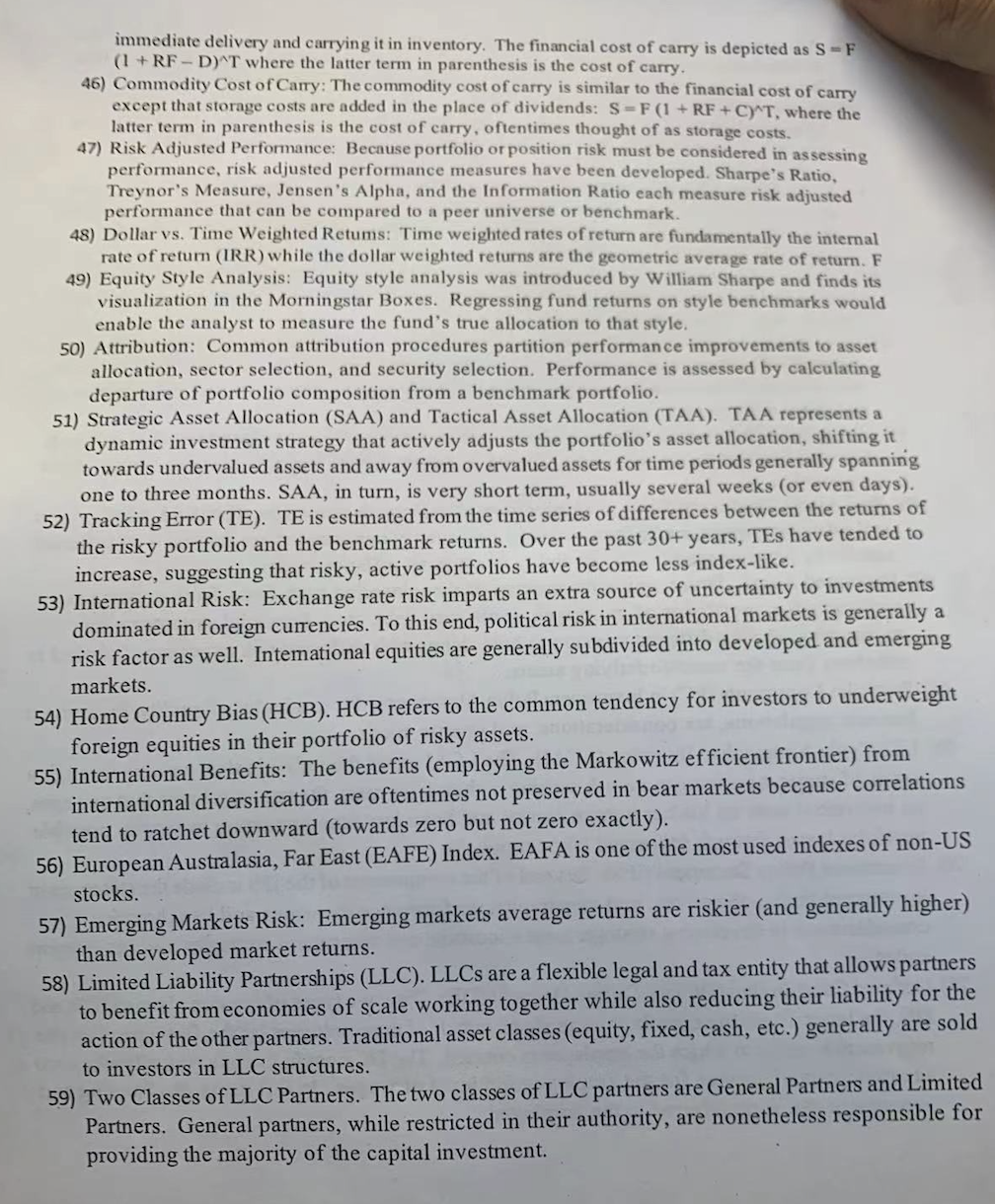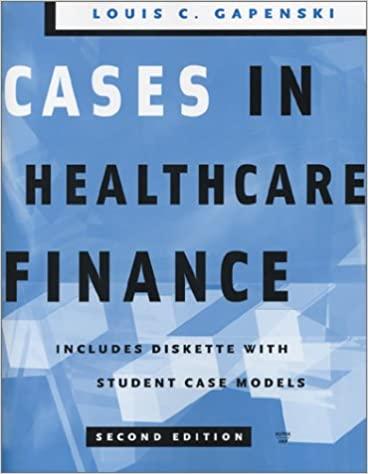T/F questions

immediate delivery and carrying it in inventory. The financial cost of carry is depicted as S=F (1+RFD)T where the latter term in parenthesis is the cost of carry. 46) Commodity Cost of Camy: The commodity cost of carry is similar to the financial cost of carry except that storage costs are added in the place of dividends: S=F(1+RF+C)T, where the latter term in parenthesis is the cost of carry, oftentimes thought of as storage costs. 47) Risk Adjusted Performance: Because portfolio or position risk must be considered in assessing performance, risk adjusted performance measures have been developed. Sharpe's Ratio, Treynor's Measure, Jensen's Alpha, and the Information Ratio each measure risk adjusted performance that can be compared to a peer universe or benchmark. 48) Dollar vs. Time Weighted Retums: Time weighted rates of return are fundamentally the internal rate of return (IRR) while the dollar weighted returns are the geometric average rate of return. F 49) Equity Style Analysis: Equity style analysis was introduced by William Sharpe and finds its visualization in the Morningstar Boxes. Regressing fund refurns on style benchmarks would enable the analyst to measure the fund's true allocation to that style. 50) Attribution: Common attribution procedures partition performan ce improvements to asset allocation, sector selection, and security selection. Performance is assessed by calculating departure of portfolio composition from a benchmark portfolio. 51) Strategic Asset Allocation (SAA) and Tactical Asset Allocation (TAA). TA A represents a dynamic investment strategy that actively adjusts the portfolio's asset allocation, shifting it towards undervalued assets and away from overvalued assets for time periods generally spanning one to three months. SAA, in turn, is very short term, usually several weeks (or even days). 52) Tracking Error (TE). TE is estimated from the time series of differences between the returns of the risky portfolio and the benchmark returns. Over the past 30+ years, TEs have tended to increase, suggesting that risky, active portfolios have become less index-like. 53) International Risk: Exchange rate risk imparts an extra source of uncertainty to investments dominated in foreign currencies. To this end, political risk in international markets is generally a risk factor as well. Intemational equities are generally subdivided into developed and emerging markets. 54) Home Country Bias (HCB). HCB refers to the common tendency for investors to underweight foreign equities in their portfolio of risky assets. 55) International Benefits: The benefits (employing the Markowitz efficient frontier) from international diversification are oftentimes not preserved in bear markets because correlations tend to ratchet downward (towards zero but not zero exactly). 56) European Australasia, Far East (EAFE) Index. EAFA is one of the most used indexes of non-US stocks. 57) Emerging Markets Risk: Emerging markets average returns are riskier (and generally higher) than developed market returns. 58) Limited Liability Partnerships (LLC). LLCs are a flexible legal and tax entity that allows partners to benefit from economies of scale working together while also reducing their liability for the action of the other partners. Traditional asset classes (equity, fixed, cash, etc.) generally are sold to investors in LLC structures. 59) Two Classes of LLC Partners. The two classes of LLC partners are General Partners and Limited Partners. General partners, while restricted in their authority, are nonetheless responsible for providing the majority of the capital investment. immediate delivery and carrying it in inventory. The financial cost of carry is depicted as S=F (1+RFD)T where the latter term in parenthesis is the cost of carry. 46) Commodity Cost of Camy: The commodity cost of carry is similar to the financial cost of carry except that storage costs are added in the place of dividends: S=F(1+RF+C)T, where the latter term in parenthesis is the cost of carry, oftentimes thought of as storage costs. 47) Risk Adjusted Performance: Because portfolio or position risk must be considered in assessing performance, risk adjusted performance measures have been developed. Sharpe's Ratio, Treynor's Measure, Jensen's Alpha, and the Information Ratio each measure risk adjusted performance that can be compared to a peer universe or benchmark. 48) Dollar vs. Time Weighted Retums: Time weighted rates of return are fundamentally the internal rate of return (IRR) while the dollar weighted returns are the geometric average rate of return. F 49) Equity Style Analysis: Equity style analysis was introduced by William Sharpe and finds its visualization in the Morningstar Boxes. Regressing fund refurns on style benchmarks would enable the analyst to measure the fund's true allocation to that style. 50) Attribution: Common attribution procedures partition performan ce improvements to asset allocation, sector selection, and security selection. Performance is assessed by calculating departure of portfolio composition from a benchmark portfolio. 51) Strategic Asset Allocation (SAA) and Tactical Asset Allocation (TAA). TA A represents a dynamic investment strategy that actively adjusts the portfolio's asset allocation, shifting it towards undervalued assets and away from overvalued assets for time periods generally spanning one to three months. SAA, in turn, is very short term, usually several weeks (or even days). 52) Tracking Error (TE). TE is estimated from the time series of differences between the returns of the risky portfolio and the benchmark returns. Over the past 30+ years, TEs have tended to increase, suggesting that risky, active portfolios have become less index-like. 53) International Risk: Exchange rate risk imparts an extra source of uncertainty to investments dominated in foreign currencies. To this end, political risk in international markets is generally a risk factor as well. Intemational equities are generally subdivided into developed and emerging markets. 54) Home Country Bias (HCB). HCB refers to the common tendency for investors to underweight foreign equities in their portfolio of risky assets. 55) International Benefits: The benefits (employing the Markowitz efficient frontier) from international diversification are oftentimes not preserved in bear markets because correlations tend to ratchet downward (towards zero but not zero exactly). 56) European Australasia, Far East (EAFE) Index. EAFA is one of the most used indexes of non-US stocks. 57) Emerging Markets Risk: Emerging markets average returns are riskier (and generally higher) than developed market returns. 58) Limited Liability Partnerships (LLC). LLCs are a flexible legal and tax entity that allows partners to benefit from economies of scale working together while also reducing their liability for the action of the other partners. Traditional asset classes (equity, fixed, cash, etc.) generally are sold to investors in LLC structures. 59) Two Classes of LLC Partners. The two classes of LLC partners are General Partners and Limited Partners. General partners, while restricted in their authority, are nonetheless responsible for providing the majority of the capital investment







